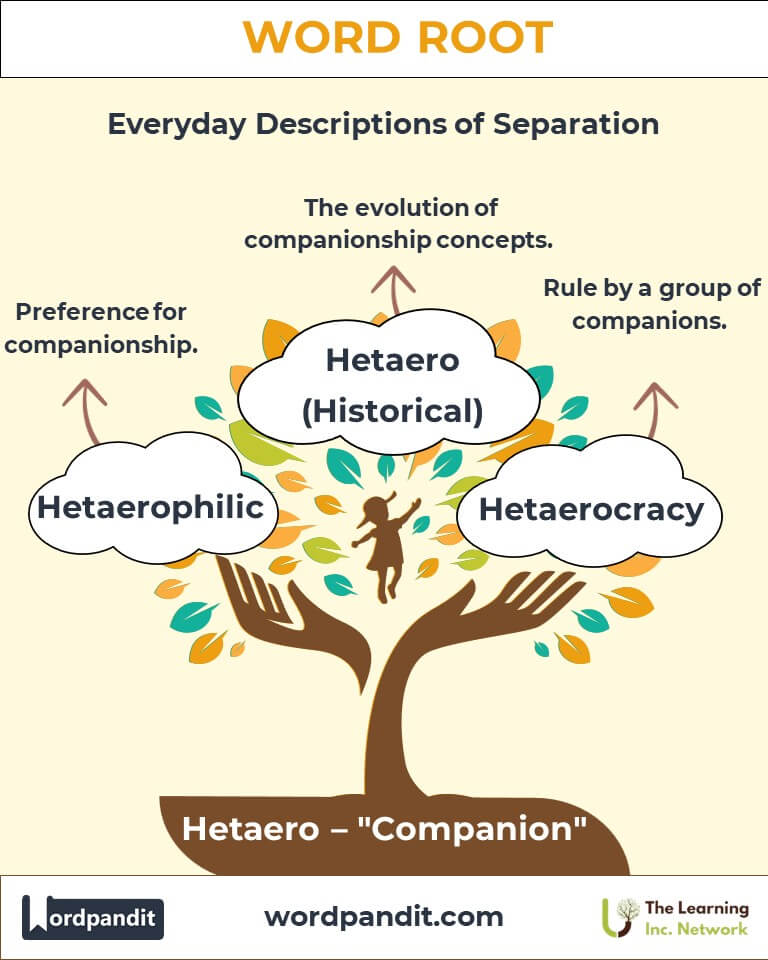Hetaero: The Companion Root in Language and Society
Explore the rich and intriguing root "Hetaero," derived from Greek, meaning "companion." This root manifests in concepts and words that emphasize relationships, companionship, and sociocultural dynamics, such as "hetaerism" and "hetaerology."

Table of Contents
- Introduction: The Essence of Hetaero
- Etymology and Historical Journey
- Mnemonic: Unlocking the Power of Hetaero
- Common Hetaero-Related Terms
- Hetaero Through Time
- Hetaero in Specialized Fields
- Illustrative Story: Hetaero in Action
- Cultural Significance of the Hetaero Root
- The Hetaero Family Tree
- FAQs about the Hetaero Word Root
- Test Your Knowledge: Hetaero Mastery Quiz
- Conclusion: The Living Legacy of Hetaero
Introduction: The Essence of Hetaero
The root "Hetaero", pronounced "he-TAY-roh," originates from the Greek word "hetairos," meaning companion or comrade. This root finds its significance in societal constructs, emphasizing companionship and collective relationships. Words derived from this root often explore aspects of group dynamics, loyalty, and partnership.

Etymology and Historical Journey
The term "hetaero" stems from the ancient Greek "hetairos" (companion) and "hetairia" (association or fellowship). In ancient Greece, the root was famously associated with hetairai, sophisticated courtesans celebrated for their wit, beauty, and companionship, often serving as cultural and intellectual partners in aristocratic circles. The root evolved into words and concepts that encapsulate various facets of companionship, both literal and metaphorical.
Mnemonic: Unlocking the Power of Hetaero
To remember "Hetaero," picture a group of close-knit friends standing arm-in-arm, symbolizing the bonds of companionship.
Mnemonic Device: "Hetaero heralds harmony—companions together in fellowship and support."
Common Hetaero-Related Terms
- Hetaerism (he-TAYR-iz-um): A social system where relationships emphasize collective companionship, often with shared responsibilities.
Example: "Some anthropologists argue that early human societies practiced forms of hetaerism to sustain communal harmony." - Hetaerology (he-tay-ROL-oh-jee): The study of companion-based relationships or systems.
Example: "Hetaerology provides insights into the intricate dynamics of ancient Greek companionship." - Hetairai (he-TAY-rye): Sophisticated courtesans in ancient Greece, celebrated for their companionship and intellect.
Example: "The hetairai played pivotal roles in fostering philosophical discourse in ancient Athens." - Hetaerocracy (he-TAY-ro-kruh-see): A society or government where power is held collectively by a group of companions or associates.
Example: "The cooperative's governance structure resembled a modern form of hetaerocracy." - Hetaerophilic (he-tay-RO-fill-ik): Attracted to or thriving in the presence of companionship.
Example: "As a naturally hetaerophilic individual, Mia thrived in team-based settings."
Hetaero Through Time
- Ancient Greece: "Hetairos" signified trusted companions in both personal and military contexts. Alexander the Great referred to his loyal cavalry as "hetairoi."
- Modern Interpretations: The concept of hetaerism has been reinterpreted to analyze early communal societies, while hetaerology explores companionship's societal implications.
Hetaero in Specialized Fields
- Anthropology: Hetaerism examines collective relational systems in early human societies.
- Sociology: Hetaerology studies modern group dynamics, partnerships, and companion-based systems.
- History: Hetairai investigates the roles of sophisticated courtesans in ancient Greece and their cultural impact.
Illustrative Story: Hetaero in Action
In ancient Athens, Lysandra, a renowned hetaira, was more than just a companion. She inspired philosophers with her keen intellect and brought together merchants, artists, and leaders in spirited dialogue. Her gatherings embodied the essence of hetaerism, proving that companionship transcends societal roles, creating a space for connection and progress.
Cultural Significance of the Hetaero Root
The concept of companionship, rooted in "hetaero," remains timeless. In modern culture, it finds echoes in social networks, cooperative systems, and even friendships, underscoring the enduring human need for connection. Ancient Greece's hetairai exemplified how companionship could foster intellectual and cultural advancements.

The Hetaero Family Tree
- Soci- (Latin: companion, ally):
- Society: A group of companions or allies living together.
- Social: Relating to companionship or group dynamics.
- Amic- (Latin: friend, companion):
- Amicable: Friendly and companionable.
- Amity: Peaceful companionship or friendship.
- Philos- (Greek: love, affinity):
- Philosophy: Love of wisdom, often shared in companionable discourse.
- Philharmonic: A group dedicated to the love of music.
FAQs About the Hetaero Root
Q: What does "hetaero" mean?
A: "Hetaero" means "companion" or "associate," derived from the Greek word "hetairos." This root emphasizes partnership, camaraderie, and collective relationships, central to words related to social dynamics and shared responsibilities.
Q: What is hetaerism?
A: Hetaerism refers to a societal system where relationships are built on communal living and collective responsibility, often emphasizing shared resources or roles. Anthropologists use this term to describe early human societies that collaborated for survival.
Q: Who were the hetairai?
A: Hetairai were distinguished companions in ancient Greece, often sophisticated and educated women who participated in cultural, social, and intellectual life. They were respected for their conversational skills and engagement in philosophical debates.
Q: What is hetaerology?
A: Hetaerology is the study of companionship and group-based systems, focusing on how relationships, partnerships, or associations evolve within social and cultural contexts. It provides insights into both ancient and modern human interactions.
Q: What is hetaerocracy?
A: Hetaerocracy describes a governance system based on collective companionship or shared leadership among associates. It emphasizes equal participation and partnership instead of hierarchical structures.
Test Your Knowledge: Hetaero Mastery Quiz
1. What does the root "hetaero" signify?
2. Which term refers to the study of companionship systems?
3. Who were the hetairai?
4. What is hetaerism associated with?
5. What does hetaerophilic describe?
Conclusion: The Living Legacy of Hetaero
The root "hetaero" symbolizes the timeless importance of companionship, from ancient Greek associations to modern studies of collective relationships. By understanding this root, we appreciate the profound role of companionship in shaping human culture and society. Let "hetaero" inspire you to value and nurture your connections, fostering a world enriched by fellowship.












